In a 60-game season, anything can happen. Through 60 games in 2018, the Mariners held the AL West lead with two wins over the Astros. The Mariners, of course, would end up finishing eight games behind the Athletics for the second Wild Card spot, but had 2018 been ravaged by coronavirus, the M’s would have made the playoffs. For the Angels, they don’t figure to be an overwhelmingly dominant team, but they don’t have to be. They just need to stagger their way into the playoffs. Once they’re in the playoffs, it’ll be important to have a good reliever to put fires out in high leverage situations. Enter Hansel Robles.
Robles hasn’t been very good for very long. Given that he doesn’t overwhelmingly strike hitters out, he’s been limited to about league-average outcomes. That’s because he’s had a bit of a home run problem and a slightly worse walk problem. At the surface level, those issues appear to have been ironed out, and his strikeouts are up too.
Comparing his 2019 against the rest of his career:
| K% | BB% | HR/9 | |
|---|---|---|---|
| 2015 – 2018 | 25.4 | 10.4 | 1.26 |
| 2019 | 26.5 | 5.7 | 0.74 |
This is all good. He upped his strikeouts by a tick, and he nearly halved his walk percentage and HR/9. Of course, home runs are incredibly noisy, so we don’t need to put too much weight into that for now, but the rest is encouraging. He’s re-made himself, to an extent. This article was actually inspired by a PL+ member, who asked me a few months ago if his lowered walk percentage was sustainable. So let’s answer that. Is it?
Yes. My answer is yes, and I’ll show you why.
Since 2015, the vast, vast majority of Robles’ walks have been four-seam fastballs. More specifically, from 2015 to 2018, 78.5% of Robles’ walks have been fastballs. That may be surprising, but it shouldn’t be. Pitchers often turn to their fastballs when behind, and 67.0% of Robles’ pitches overall have been fastballs. Since his fastball hasn’t been helping him out, let’s take a look at his pitch usage over the years.
| FF | SL | CH | |
|---|---|---|---|
| 2015 | 71.9 | 27.2 | 0.8 |
| 2016 | 63.9 | 24.0 | 12.1 |
| 2017 | 67.5 | 24.6 | 8.0 |
| 2018 | 66.8 | 28.3 | 3.7 |
| 2019 | 53.1 | 21.6 | 22.4 |
His fastballs have finally given way, but his slider has too! To make up the difference, Robles has increased the usage of his change by more than five times from last year. This pretty much came out of nowhere, given Robles’ changeup hasn’t been good, so he hasn’t used it very much, accordingly.
You’ll see that it took Robles a good deal of time to start using his changeup over the course of the year. But once he ramped it up, he started throwing quite a few changeups:
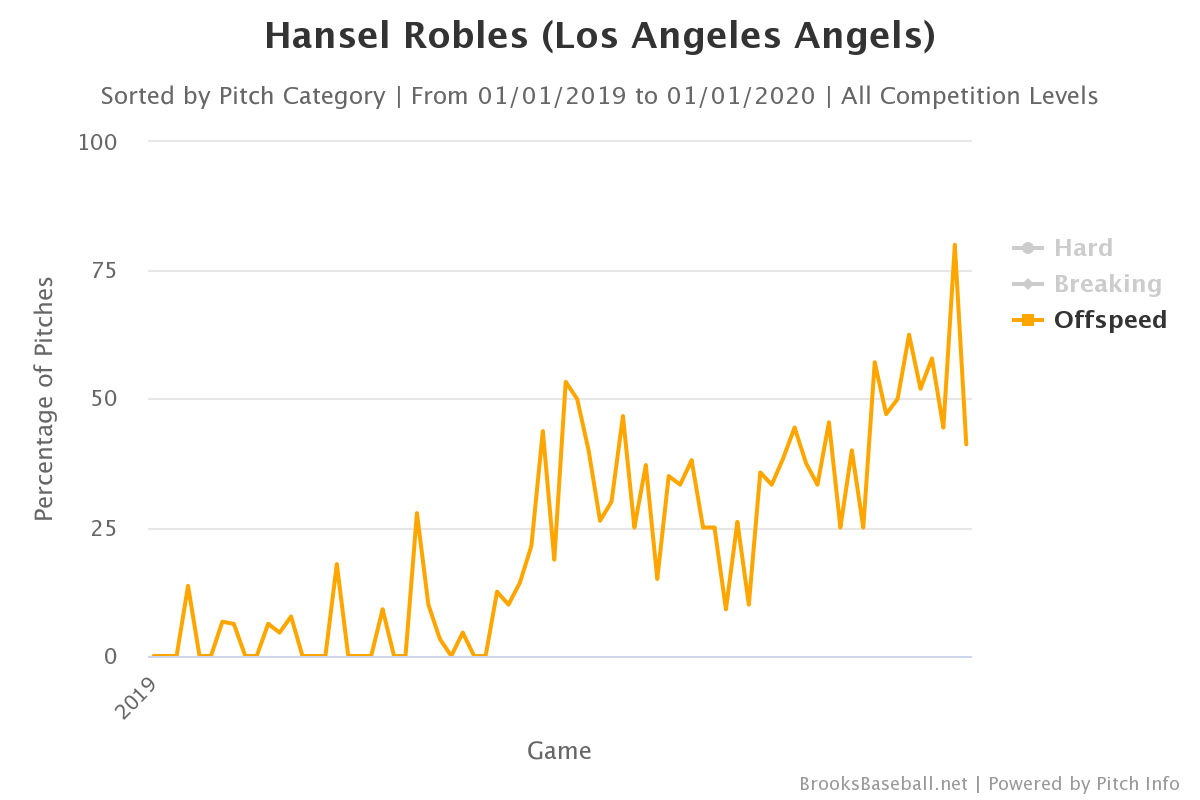
Of course, lefties account for most of the pitches thrown. What’s interesting to me, though, is he started to use it against righties too. Robles’ pitch usage since 2015, grouped by hard and offspeed pitches:
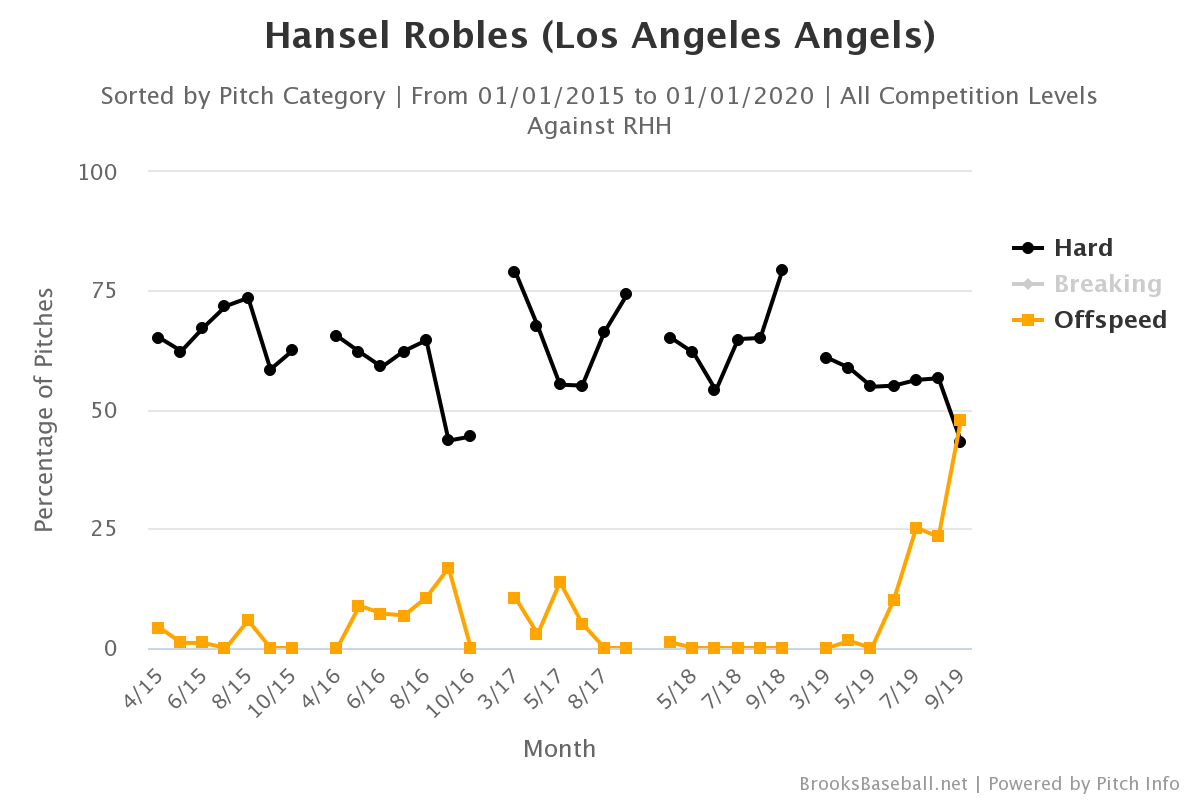
That’s a rare thing. Generally speaking, pitchers don’t throw many changeups to hitters of the same handedness since they break towards them. In 2019, 69.5% of changeups from right-handed pitchers were to left-handed batters. As it follows, just 30.5% were to right-handed batters. As the year went on, Robles continued to go against the grain. Through June 15th, Robles ranked in the 14th percentile in the proportion of his total changeups that were to same-handed hitters. From June 15th on, Robles ranked in the 74th percentile, and from September 1st on, he ranked in the 82nd percentile. Through the first half of the year, he was well below-average in this regard, and then in the second half, he was above-average.
And there’s a reason for the change in pitch mix! I noted earlier that his changeup wasn’t good, and it wasn’t. Up until 2019, his career swinging-strike percentage on his changeup was just 9.7%. In 2019, that leaped all the way to 19.3%. So, what changed?
The short answer is that the pitch itself changed completely. We can see he’s widened the velocity gap between his fastball and changeup:
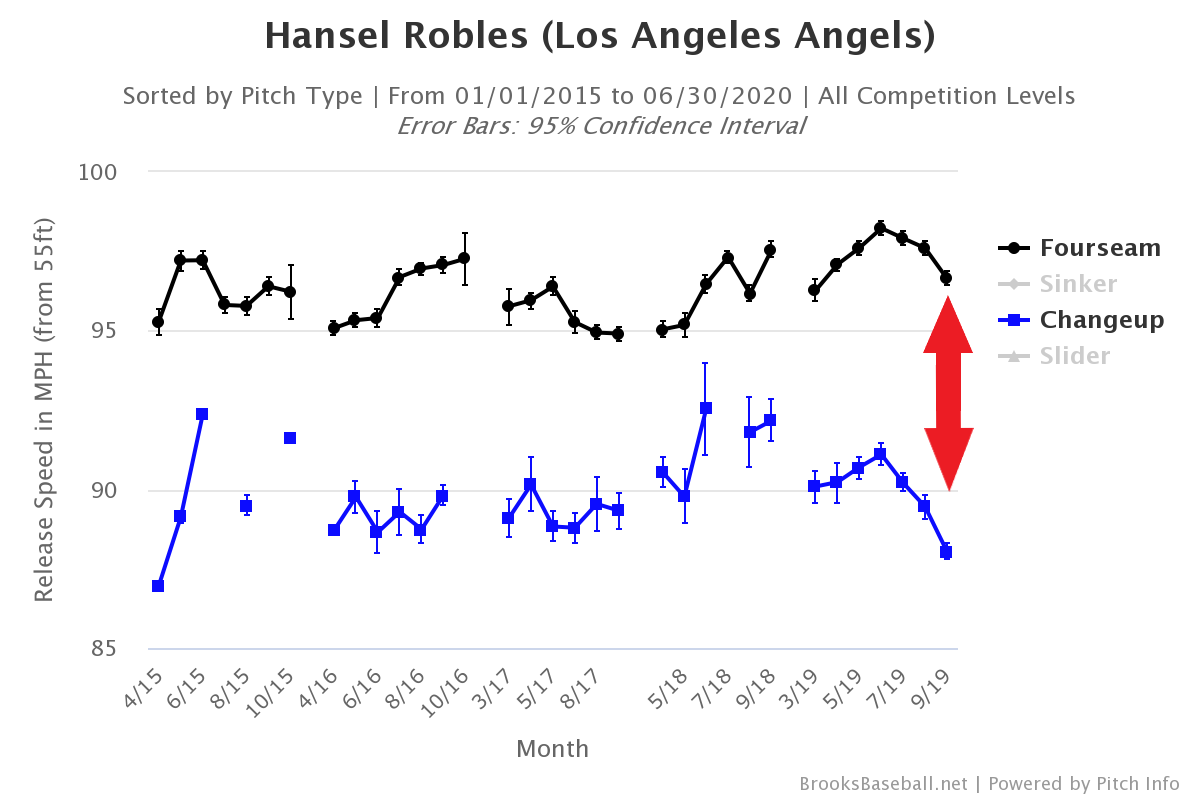
By the last month of the year, Robles’ changeup was unlike it’s ever been by velocity. It’s hard to eyeball, but by the end of the year, his velocity gap (as denoted by the red arrow) was around seven to eight miles per hour. Over his career, his norm has been five to seven.
Again, by the end of the year, his changeup was significantly different by horizontal movement too:
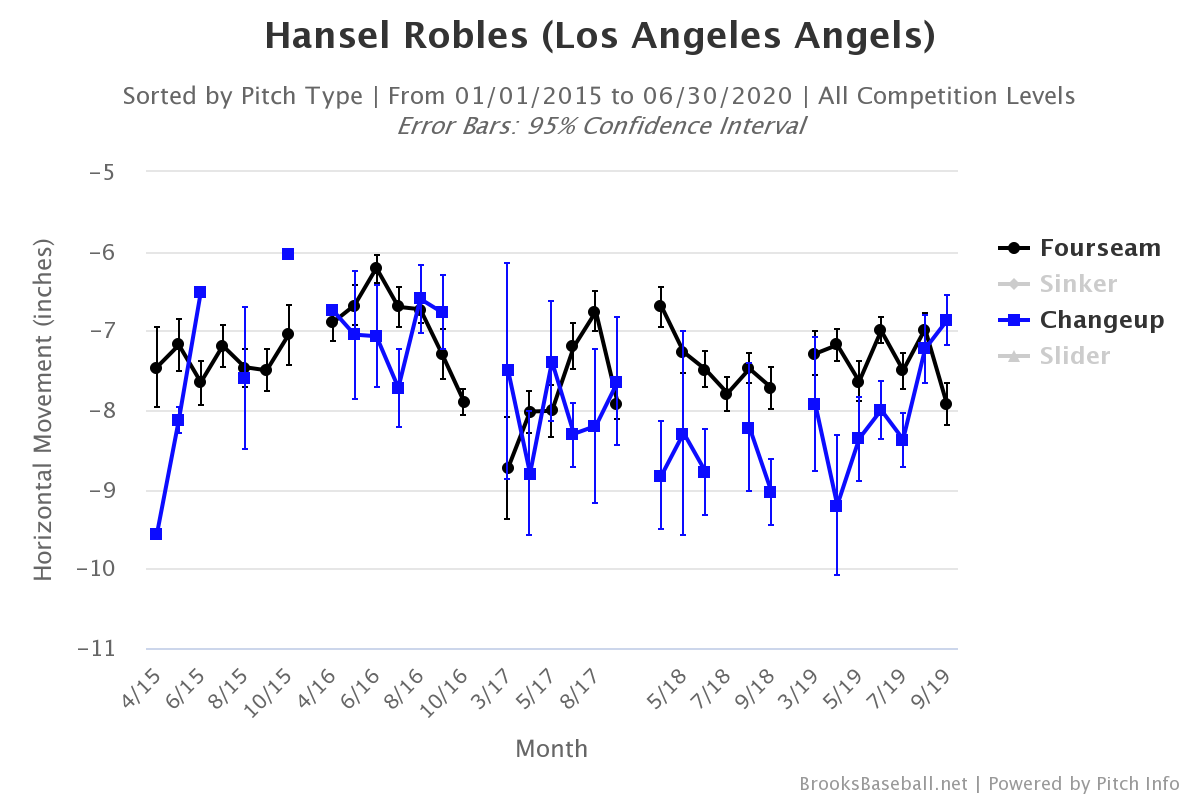
You can see that the error bars are quite large for previous years, but his fastball was getting so much arm-side movement (and his changeup such little) that they actually swapped places. In other words, his fastball started to get more horizontal movement than his changeup. That’s pretty interesting!
And lastly, by vertical movement:
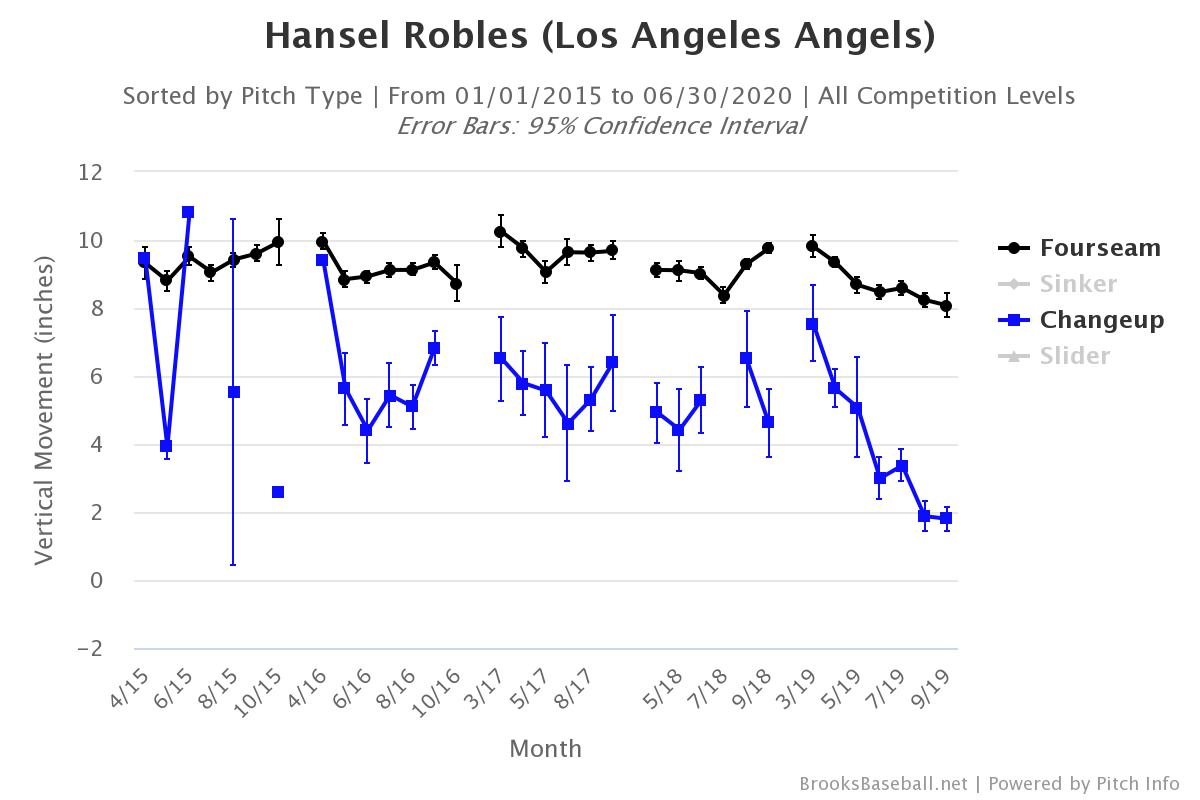
Again, unprecedented changes in movement. His changeup is getting more drop than it ever has. The end result is that when he throws his changeup right below the zone, he gets whiffs at a rate that is nearly unparalleled.
With these changes, there’s only one more change I’d like to see Robles make, and I think it could be a significant one. Given that his grades out as plus in velocity, spin rate, and active spin rate, I’d like to see him elevate his fastball.
Here’s where he’s pitching:
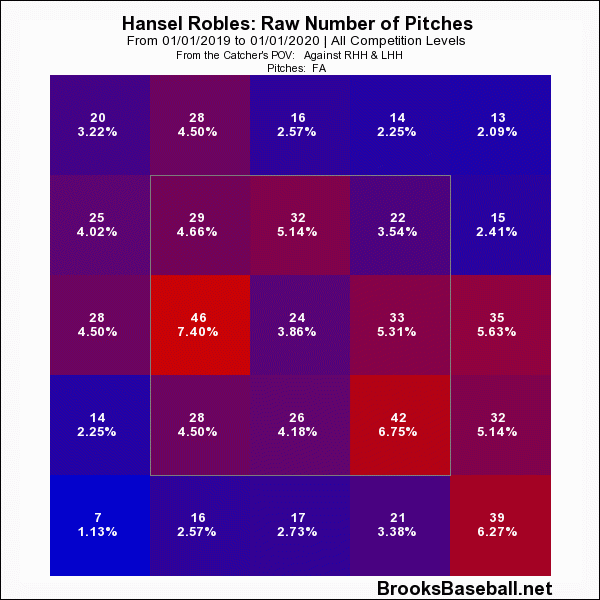
This looks messy, but that’s because he pitches lefties to his arm-side and righties to his glove-side. He’s trying to keep his fastballs away from hitters.
That’s quite judicious to pitch away on his part, but he’s missing out on a lot of whiffs — especially within the yellow square:
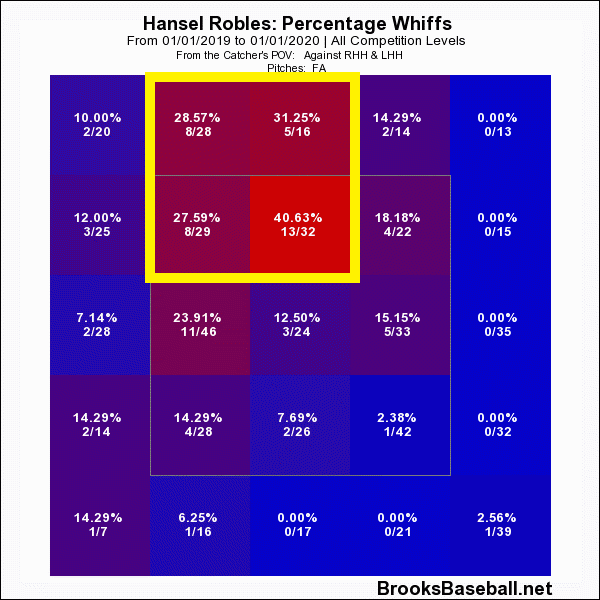
His fastball plays really, really well at the top of the zone. He certainly doesn’t need to throw his fastballs there every time, but if he starts to drift more up there, it’ll run up his swinging-strike percentage, and it would probably serve his changeup and slider well too. For how hard he throws and how well he spins his fastball, its swinging-strike percentage should look more like Emilio Pagan’s 18.3% than his own 10.9%.
Future changes notwithstanding, we have a vastly improved pitcher before us. It was just 11.1 innings, but in September, Robles threw more changeups than fastballs, and he was rewarded with a 35.0 K-BB%. A lot of what I’m doing here is projecting what he could look like moving forward, but Robles has already shown us who he can be. He was insane in his last month of baseball, and that’s because he started using his changeup more. Now imagine if he optimizes how he’s using his fastball.
In the end, I would probably bet against the Angels making the playoffs. But if they do, they have an improved Hansel Robles, and he still has some tweaks he could feasibly make that could push him into elite territory. For now, Robles misses bats, avoids walks, and when hitters make contact, it’s often on the ground; he does everything you want him to. And he might keep getting better.
Hansel Robles by John Cordes/Icon Sportswire | Adapted by Zach Ennis (@zachennis on Twitter and Instagram)

